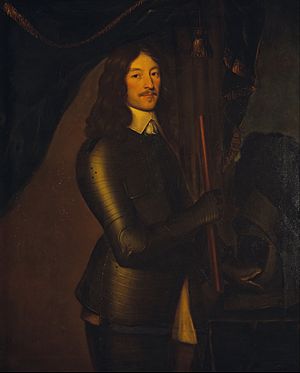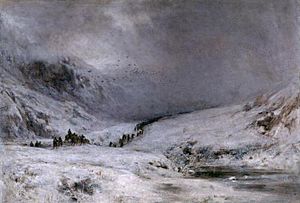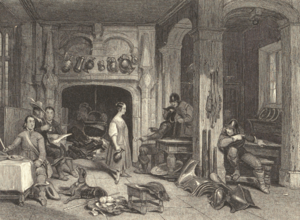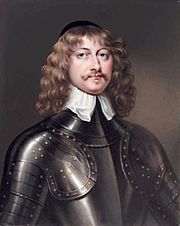James Graham, 1st Marquess of Montrose facts for kids
Quick facts for kids
The Most Honourable
The Marquess of Montrose
|
|
|---|---|
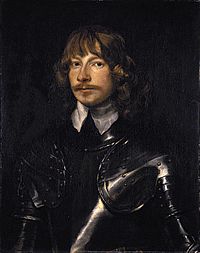
Portrait by Anthony van Dyck, 1636
|
|
| Born | 1612 Scotland
|
| Died | 21 May 1650 (aged 37) Mercat Cross, Edinburgh, Scotland
|
| Cause of death | Execution by hanging |
| Resting place | St. Giles' Cathedral, Edinburgh, Scotland |
| Nationality | Scottish |
| Other names | The Great Montrose |
| Alma mater | University of St Andrews |
| Occupation | Chief of Clan Graham, soldier, poet |
| Title | Lord Lieutenant and captain-general of Scotland, 1st Marquess of Montrose, 5th Earl of Montrose |
| Spouse(s) | Magdalene Carnegie |
| Children | James Graham, 2nd Marquess of Montrose |
| Parent(s) | John Graham, 4th Earl of Montrose Mary Ruthven |
James Graham, 1st Marquess of Montrose (1612 – 21 May 1650) was an important Scottish nobleman, a poet, and a skilled soldier. He was also a viceroy (a ruler acting for a king) and a captain general of Scotland. People often called him the Great Montrose because of his amazing military victories.
Montrose first joined a group called the Covenanters. They wanted to protect the Scottish church from the King's changes. But as the English Civil War began, Montrose changed his mind. He decided to support King Charles I. From 1644 to 1646, and again in 1650, he led armies for the King in the civil war in Scotland.
After a battle where he was defeated and captured, Montrose was put on trial by the Scottish Parliament. He was sentenced to death by hanging. Years later, after King Charles II returned to power, Montrose was given a grand funeral. His reputation changed from being seen as a traitor to a brave hero. His surprising victories are still studied today for their clever military plans.
Contents
Early Life and Education
James Graham was the leader, or Chief, of Clan Graham. He was the only son of John Graham, 4th Earl of Montrose, and Lady Margaret Ruthven. We don't know the exact date or place he was born, but it was likely in October 1612.
When he was twelve, Montrose studied at the college of Glasgow. He read books by famous ancient writers like Xenophon and Seneca. He also enjoyed History of the World by Walter Raleigh. When his father died in 1626, James became the 5th Earl of Montrose. He then continued his education at Saint Salvator's College at the University of St Andrews.
At seventeen, he married Magdalene Carnegie. She was the youngest of six daughters of David Carnegie. They had four sons, including James Graham, 2nd Marquess of Montrose.
From Covenanter to Royalist
In 1638, King Charles I tried to make the Scottish church more like the English church, using a new prayer book. Many Scots resisted this. This led to conflicts known as the Bishops' Wars. Montrose first joined the group that resisted the King, called the Covenanters. He was a very active leader for them.
Montrose signed the National Covenant, which was an agreement to protect the Scottish church. He helped lead an army to stop people who supported the King in areas like Aberdeen. He entered Aberdeen three times. During one visit, the leader of the King's supporters, the Marquess of Huntly, went with Montrose to Edinburgh. This helped convince King Charles I to make some agreements with the Covenanters.
In 1639, after a peace treaty was signed, Montrose visited King Charles. Montrose began to change his mind about who to support. He wanted to get rid of the bishops' power in the church. But he didn't want the Presbyterians (the Covenanters' church leaders) to have too much power over the government. He believed the King should keep law and order, and the church should focus on spiritual matters.
In the Scottish parliament, Montrose found himself against Archibald Campbell, 1st Marquess of Argyll. Argyll was becoming the main leader of the Presbyterian and national party. Montrose wanted the King to use his power to stop Argyll. He offered the King support from many nobles. However, the King still wouldn't give up on the bishops. Also, no strong Scottish group could form without Presbyterianism being the main church power.
In 1640, the King prepared to invade Scotland. Montrose had to be careful. He signed a protest against Argyll's growing power. But he also fought to defend Scotland. He showed his bravery in a battle at the River Tyne at Newburn. In 1641, he was accused of working against Argyll and was put in Edinburgh Castle. When King Charles visited Scotland and agreed to remove bishops, Montrose was set free.
Montrose's Military Campaigns
In 1644, King Charles made Montrose the Lord Lieutenant of Scotland. A year later, in 1645, the King made him captain general. Montrose's military campaigns were known for being very fast. He used surprise attacks to defeat his enemies, even when they had many more soldiers.
The Highland clans had never really worked together before. But Montrose knew that many western Highland clans, especially the MacDonalds, disliked Argyll and his Campbell clansmen. So, many clans joined Montrose. The King's allies in Ireland also sent 2,000 trained Irish soldiers to help him. These Irish soldiers were very strong fighters.
In two campaigns, Montrose moved quickly and won six battles against his opponents.
- At Tippermuir and Aberdeen, he defeated the Covenanter armies.
- At Inverlochy, he crushed the Campbells.
- At Auldearn, Alford, and Kilsyth, he won against well-trained armies.
The fierce spirit of the Gordons and other clans often helped win the day. But Montrose also relied on the disciplined Irish soldiers. His plans at Inverlochy and his tactics at Aberdeen, Auldearn, and Kilsyth are still studied as great examples of military skill. His string of victories ended with the big Battle of Kilsyth on 15 August 1645. His military fame was so great that King Louis XIV of France offered him a high position in his army.
After Kilsyth, Montrose seemed to be in control of Scotland. The King's secretary arrived and confirmed Montrose's high military titles. Montrose planned for a parliament to meet in Glasgow. He hoped to unite loyalty to the King with a church led by non-political Presbyterians. But this parliament never met.
King Charles had been defeated at the Battle of Naseby in England. Montrose needed to help the King. David Leslie, a top Scottish general, was sent to stop Montrose. On 12 September, Leslie found Montrose at Philiphaugh. Montrose's Highland soldiers had left him, and he had only a small group of followers. Leslie easily won the battle. Montrose escaped to the Highlands but couldn't gather another army. In September 1646, he sailed to Norway.
Stories of his victories reached other countries. He was offered a job as a general in the French army. The Emperor Ferdinand III even made him a field marshal. But Montrose remained loyal to King Charles and later to his son, Charles II.
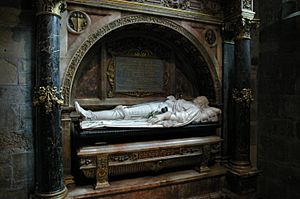
Montrose returned to Scotland one more time. In June 1649, he wanted to get revenge for the King's death. The exiled Charles II made him the leader of Scotland again. However, Charles II later abandoned Montrose to become King on terms set by Argyll and his supporters.
In March 1650, Montrose landed in Orkney with a small force. He tried to get the clans to join him, but he failed. On 27 April, he was surprised and defeated at the Battle of Carbisdale in Ross-shire. He escaped the battle but was later captured by Neil MacLeod of Assynt. Montrose had trusted MacLeod, not knowing he was an enemy.
Montrose was taken prisoner to Edinburgh. On 20 May, the parliament sentenced him to death. He was hanged on 21 May. A book praising him was hung around his neck. Until the end, he insisted he was a loyal subject and a true Covenanter. His head was displayed on the Old Tolbooth outside St Giles' Cathedral until 1661.
After Montrose's death, the Scottish government changed sides and supported Charles II. After the King returned to power in 1660, Montrose was officially honored. On 7 January 1661, Montrose's body was moved from where it was buried. His head was taken from the spike, and his body was carried to Holyrood Abbey.
Montrose's limbs, which had been sent to different towns, were brought back and placed in his coffin. A grand funeral was held in St. Giles on 11 May 1661.
Montrose's Battles
Montrose had many victories in battle:
- The Battle of Tippermuir, with help from Alasdair MacColla and his Irish soldiers.
- The Battle of Aberdeen.
- The Battle of Inverlochy.
- The Battle of Auldearn.
- The Battle of Alford.
- The Battle of Kilsyth.
After several years of winning battles, Montrose was finally defeated at the Battle of Philiphaugh on 13 September 1645. This defeat was by the Covenanter army led by David, Lord Newark.
In March 1650, he captured Dunbeath Castle. The Clan Sinclair, who owned the castle, later supported him at Carbisdale. Montrose was defeated at the Battle of Carbisdale by the Munros, Rosses, Sutherlands, and Colonel Archibald Strachan.
Montrose in Books and Poems
Montrose's life has inspired many writers.
In Fiction
- A Legend of Montrose (1819) by Sir Walter Scott
- John Splendid (1898) by Neil Munro
- Witch Wood by John Buchan (1927)
- And No Quarter by Maurice Walsh (1937)
- The Bride (1939) and The Proud Servant (1949) by Margaret Irwin
- The Young Montrose (1972) and Montrose:The Captain-General (1973) by Nigel Tranter
- Graham came by Cleish (1973) by James L. Dow
- Lady Magdalen (2003) by Robin Jenkins. This book focuses on Montrose's wife, Magdalen.
In Poetry
In 1751, the poet Alasdair Mac Mhaighstir Alasdair wrote a poetry collection. It was called Ais-Eiridh na Sean Chánoin Albannaich, which means "The Resurrection of the Old Scottish Language." In this book, he translated some of Montrose's famous statements into Gaelic. These statements showed Montrose's loyalty to the House of Stuart during the English Civil War.
Images for kids


